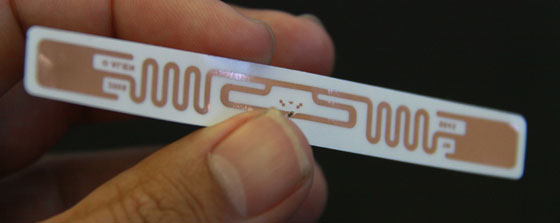RFID label, RFID UHF tag, RFID inlay manufacturer / supplier in China, offering RFID Card Inlay Dry/Wet RFID Inlay (125kHz/13.56MHz) , AET62 NFC Reader With Fingerprint Sensor, 13.56MHz Card Mifare 1k Card RFID Card Access Control Card Hotel Key Card and so on. What is an RFID tag? An RFID tag is an object that can be attached to or incorporated into a product, animal, or person for the purpose of identification using radio waves. The main difference is that the barcode must come in direct contact to an optical scanner/reader and the RFID tag can transmit to the reader via radio waves and does not have to be in direct contact.
This gives RFID tags a distinct advantage over optically read items, such as barcodes, which would be useless under similar conditions. RFID tags consist of a microchip connected to an antenna, which is constructed of a small coil of wires. A passive RFID tag draws its power from this magnetic field, which powers the circuits in the microchip allowing it to transmit data back to the reader. RFID tags operate under different radio frequencies, depending on the application.
The most expensive read/write, active RFID transponders may have microchips with a memory capacity of up to one megabyte (1,000,000 characters). The main difference is that the barcode must come in direct contact to an optical scanner/reader and the RFID tag can transmit to the reader via radio waves and does not have to be in direct contact. Testing of RFID antenna is usually performed with ohmmeters, milliohm meters, RF network analyzers, impedance-measuring equipment, and others. RFID tags can be manufactured in several different shapes and sizes depending on the type of application in which they will be used.
The FCC of the US government determines the limits on power output of RFID systems as well as the different radio frequencies that can be used. The communication range between the RFID tag and the reader depends on the frequency, the antenna size of the tag, the antenna size of the reader, and the output power. This gives RFID antenna a distinct advantage over optically read items, such as barcodes, which would be useless under similar conditions. Quality control is a necessity because groups of manufactured inlays may have experienced some damage before they reach the printer or converter. The printers can read, write, and print labels that have an embedded RFID transponder.
The chips in the inlays can also be damaged during the printing or converting process, which renders the RFID tag useless. When RFID antenna are manufactured, they are usually tested with ohmmeters, milliohm meters, RF network analyzers, and impedance-measuring equipment. Label printing is one of the fastest growing segments of the printing industry using RFID technology.







